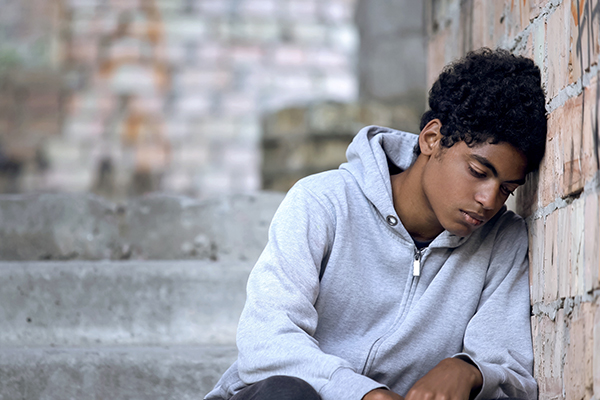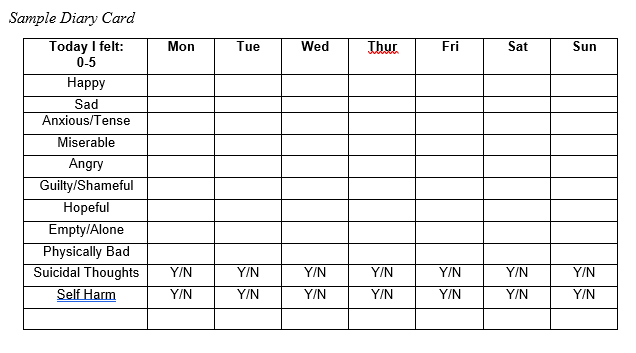
Mental Health Awareness and Diary Cards
Mental Health Awareness and Diary Cards
Alex Baker, Psy.D.
Camino a Casa Clinical Supervisor
“Doesn’t everyone have anxiety and depression since the pandemic began?” It certainly feels that way! The Center for Disease Control (CDC) noted that 40% of adults experienced symptoms of depression or anxiety between August 2020 and January 2021, a 17% increase from prior years. Their study also found an increase in adults requiring mental health treatment and psychiatric medications. Research conducted by the CDC has shown patterns of mental health needs in youth based on developmental ages, with younger children showing more signs of externalizing disorders while older children show higher rates of anxiety and depression. Mental Health America noted that from 2019-2020, the number of teens in the US with a depressive episode increased by nearly 121,000. With the rise in mental health symptoms since COVID-19 began, noticing the signs and being aware of relevant treatments has become essential.

Warning Signs
When most people think of depression and anxiety, they might think of someone crying, struggling to get out of bed, and feeling worried all the time. While these can be common symptoms, depression and anxiety can present differently between individuals, especially children. Children and youth with anxiety and depression often report the following problems:
- Difficulty focusing and concentrating
- Restlessness
- Stomachaches and headaches
- Feelings of unexplained anger and irritability
- Peer conflicts and avoidance
- Trouble falling and staying asleep
- Nausea and changes in eating habits
Those with externalizing behaviors, meaning those that can be seen by others (i.e., punching walls, running away, shouting) are often recognized and receive support earlier. However, many youth strive to avoid “being found out,” anticipating conflicts and additional stress as a result of opening up. This may lead to internalized symptoms (i.e., feelings of worthlessness, misinterpreting social situations, isolating, and suicidal thoughts) that build up over time. Often these symptoms go unnoticed or normalized as “typical teenage mood swings”, which may lead to delays in their diagnosis for months or even years. While this may contribute towards feelings of guilt and uncertainty for caregivers, the good news is that there is hope and ways to help.
What you can do
If you’re noticing many of these common symptoms of mental health challenges in your child, start the conversation. Often parents might wonder if bringing up these difficult topics might exacerbate symptoms or cause offense. Depending on their developmental age, children may not yet have the communication skills to acknowledge what they are going through. By opening the door to these conversations, we can normalize the challenges they’re facing while letting them know, “It’s okay to not be okay.” Stigma and fear of subtle signs of invalidation, humiliation, or rejection is often a reason that our youth might avoid discussing their depression and anxiety with their caregivers. It may also be helpful to have an open discussion with your child on whether therapy might be beneficial. While many youth report they’ve done therapy before and “it didn’t work,” there are many different forms of treatment designed to uniquely address their needs.
From Our Toolbox – Dear Diary Card
The Camino a Casa program provides short-term services to youth ages 9-17, including residential, partial hospitalization, and intensive outpatient services. Youth in our program struggle with intense mood dysregulation, often including depression and anxiety. These symptoms have often been developing over the course of years, building up into intense suicidal thoughts and self-harming behaviors. In order to effectively address this, Camino a Casa utilizes an evidence-based therapy known as Dialectical Behavior Therapy (DBT), which focuses on mindfulness, emotion regulation, distress tolerance, and interpersonal effectiveness.
To track these unsafe behaviors and frequent emotional shifts, clinicians work with the youth to collaboratively develop what’s known as a “diary card.” This provides a simple and consistent way to track the youth’s emotional experiences and urges to engage in destructive behaviors throughout the week. By attaching numerical ratings to their thoughts, feelings, and urges, the youth and clinician work in tandem to complete a “behavioral chain” to better understand causes of maladaptive patterns and help find realistic solutions. DBT sessions bring attention to these patterns to help backtrack and find out what led to the escalation of symptoms and what DBT skills are needed to make sure it doesn’t happen again. This often includes strategies to regulate the autonomic arousal system, including paced breathing, progressive muscle relaxation, and using cold sensations to shift the youth’s level of agitation.
Sample Diary Card

Camino a Casa offers a range of services and may be helpful in guiding you and your family towards the next step in their mental health journey. For more information, please contact admissions at (805) 366-4040.
References
- Perou R, Bitsko RH, Blumberg SJ, Pastor P, Ghandour RM, Gfroerer JC, Hedden SL, Crosby AE, Visser SN, Schieve LA, Parks SE, Hall JE, Brody D, Simile CM, Thompson WW, Baio J, Avenevoli S, Kogan MD, Huang LN. Mental health surveillance among children – United States, 2005—2011. MMWR 2013;62(Suppl; May 16, 2013):1-35.
- Danielson ML, Bitsko RH, Ghandour RM, Holbrook JR, Blumberg SJ. Prevalence of parent-reported ADHD diagnosis and associated treatment among U.S. children and adolescents, 2016. Journal of Clinical Child and Adolescent Psychology. Published online before print January 24, 2018.
- Ghandour RM, Sherman LJ, Vladutiu CJ, Ali MM, Lynch SE, Bitsko RH, Blumberg SJ. Prevalence and treatment of depression, anxiety, and conduct problems in U.S. children. The Journal of Pediatrics, 2018. Published online before print October 12, 2018
- Bitsko RH, Holbrook JR, Ghandour RM, Blumberg SJ, Visser SN, Perou R, Walkup J. Epidemiology and impact of healthcare provider diagnosed anxiety and depression among US children. Journal of Developmental and Behavioral Pediatrics. Published online before print April 24, 2018
- Cree RA, Bitsko RH, Robinson LR, Holbrook JR, Danielson ML, Smith DS, Kaminski JW, Kenney MK, Peacock G. Health care, family, and community factors associated with mental, behavioral, and developmental disorders and poverty among children aged 2–8 years — United States, 2016. MMWR, 2018;67(5):1377-1383.
- Visser SN, Danielson ML, Bitsko RH, Perou R, Blumberg SJ. Convergent validity of parent-reported attention-deficit/hyperactivity disorder diagnosis: A cross-study comparison. JAMA Pediatrics. 2013; 167(7):674-675.
- US Department of Health and Human Services Health Resources and Services Administration & Maternal and Child Health Bureau. Mental health: A report of the Surgeon General. Rockville, MD: US Department of Health and Human Services, Substance Abuse and Mental Health Services Administration, Center for Mental Health Services, and National Institutes of Health, National Institute of Mental Health; 1999
- Vahratian A, Blumberg SJ, Terlizzi EP, Schiller JS. Symptoms of Anxiety or Depressive Disorder and Use of Mental Health Care Among Adults During the COVID-19 Pandemic — United States, August 2020–February 2021. MMWR Morb Mortal Wkly Rep. ePub: 26 March 2021. DOI: DX Doi



